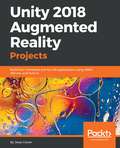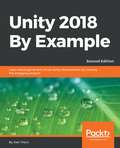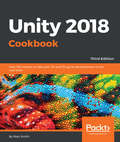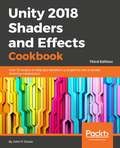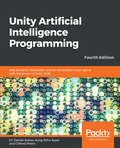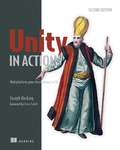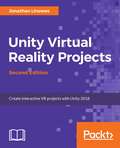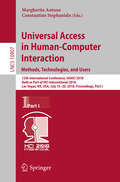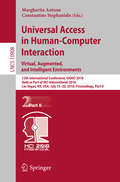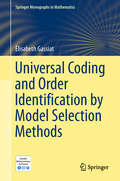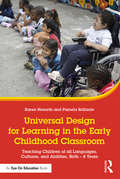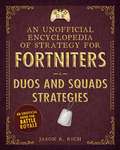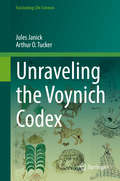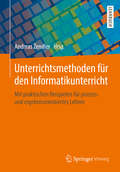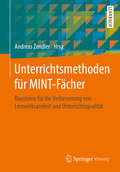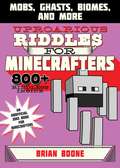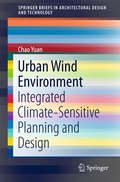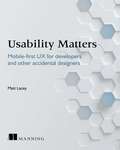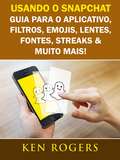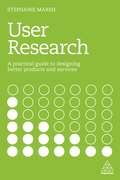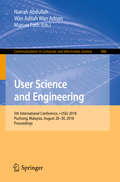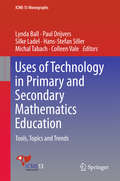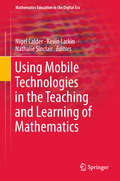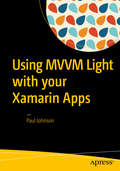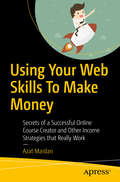- Table View
- List View
Unity 2018 Augmented Reality Projects: Build four immersive and fun AR applications using ARKit, ARCore, and Vuforia
by Jesse GloverCreate engaging Augmented Reality (AR) applications with Unity 3D that can be experienced with devices such as HoloLens and DaydreamKey FeaturesLearn the principles of AR application development Work with the most popular sensors used in AR games and applications across Android, Apple and WindowsBuild experiences with interactive objects, physics, UI, animations, and C# scriptingBook DescriptionAugmented Reality allows for radical innovations in countless areas. It magically blends the physical and virtual worlds, bringing applications from a screen into your hands. Meanwhile, Unity has now become the leading platform to develop augmented reality experiences, as it provides a great pipeline for working with 3D assets.Using a practical and project-based approach, Unity 2018 Augmented Reality Projects educates you about the specifics of augmented reality development in Unity 2018.This book teaches you how to use Unity in order to develop AR applications which can be experienced with devices such as HoloLens and Daydream. You will learn to integrate, animate, and overlay 3D objects on your camera feed, before gradually moving on to implementing sensor-based AR applications. In addition to this, you will explore the technical considerations that are especially important and possibly unique to AR. The projects in the book demonstrate how you can build a variety of AR experiences, whilst also giving insights into C# programming as well as the Unity 3D game engine via the interactive Unity Editor.By the end of the book, you will be equipped to develop rich, interactive augmented reality experiences for a range of AR devices and platforms using Unity.What you will learnBuild and run AR applications for specific headsets, including HoloLens and DaydreamCreate 3D scenes with Unity and other 3D tools while learning about world space and scaleMove around your AR scenes using locomotion and teleportationCreate filters or overlays that work in tandem with facial recognition softwareUse GPS, geolocation services, and the camera feed to create a fitness applicationIntegrate AR and VR concepts together in a single applicationWho this book is forUnity 2018 Augmented Reality Projects is for you if you're a game developer familiar with 3D computer graphics and interested in building your own AR games or applications. Any experience in Unity and C# is an advantage.
Unity 2018 By Example: Learn about game and virtual reality development by creating five engaging projects, 2nd Edition
by Alan ThornBuild exciting 2D/3D games and virtual reality applications with the help of hands-on examplesKey FeaturesCreate five different types of games from scratch with Unity 2018Import custom content into Unity from third-party tools such as Maya and Blender Learn to build NPCs with artificial intelligent behavior. Book DescriptionUnity is the most exciting and popular engine used for developing games. With its 2018 release, Unity has become the primary source of both game development and virtual reality content.In Unity 2018 By Example, you’ll learn how to use Unity in order to make amazing games from popular genres - from action shooters to mind-bending puzzle games to adventure and Virtual Reality (VR) games. Even if you have no previous experience of using Unity, this book will help you understand the toolsets it provides in depth. In addition to this, you'll understand how to create time-critical collection games, twin-stick space shooters, platformers, and action-fest games with intelligent enemies. Finally, you'll get to grips with creating VR games with the new toolsets introduced by Unity to help you develop amazing VR experiences.To make things easier, you will be provided with step-by-step tutorials for making five great games in Unity 2018, along with a detailed explanation of all the fundamental concepts. By the end of this book, you’ll have established a strong foundation in making games with Unity 2018.What you will learnUnderstand core Unity concepts, such as game objects, components, and scenesStudy level-design techniques for building immersive and interesting worldsMake functional games with C# scriptingUse the toolset creatively to build games with different themes and stylesHandle player controls and input functionalityWork with terrains and world-creation toolsGet to grips with making both 2D and 3D gamesWho this book is forYou don't need to have any previous experience with Unity to enjoy Unity 2018 By Example, although you need to have basic knowledge of C#.
Unity 2018 Cookbook: Over 160 recipes to take your 2D and 3D game development to the next level, 3rd Edition
by Matt SmithDevelop quality game components and solve common gameplay problems with various game design patternsKey FeaturesBecome proficient at traditional 2D and 3D game developmentBuild amazing interactive interfaces with Unity's UI systemDevelop professional games with realistic animation and graphics, materials and cameras, and AI with Unity 2018Book DescriptionWith the help of the Unity 2018 Cookbook, you’ll discover how to make the most of the UI system and understand how to animate both 2D and 3D characters and game scene objects using Unity's Mecanim animation toolsets.Once you’ve got to grips with the basics, you will familiarize yourself with shaders and Shader Graphs, followed by understanding the animation features to enhance your skills in building fantastic games. In addition to this, you will discover AI and navigation techniques for nonplayer character control and later explore Unity 2018’s newly added features to improve your 2D and 3D game development skills. This book provides many Unity C# gameplay scripting techniques.By the end of this book, you'll have gained comprehensive knowledge in game development with Unity 2018.What you will learnGet creative with Unity’s shaders and learn to build your own shaders with the new Shader Graph toolCreate a text and image character dialog with the free Fungus Unity pluginExplore new features integrated into Unity 2018, including TextMesh Pro and ProBuilderMaster Unity audio, including ducking, reverbing, and matching pitch to animation speedsWork with the new Cinemachine and timeline to intelligently control camera movementsImprove ambiance through the use of lights and effects, including reflection and light probesCreate stylish user interfaces with the UI system, including power bars and clock displaysWho this book is forUnity 2018 Cookbook is for you if you want to explore a wide range of Unity scripting and multimedia features and find ready-to-use solutions for many game features. This book also helps programmers explore multimedia features. It is assumed that you already know basics of Unity and have some programming knowledge of C#.
Unity 2018 Shaders and Effects Cookbook: Transform your game into a visually stunning masterpiece with over 70 recipes, 3rd Edition
by John P. Doran Alan ZucconiBring realism to your games by mastering post-processing effects and advanced shading techniques in Unity 2018Key FeaturesLearn the secrets of creating AAA quality shaders without writing long algorithmsMaster shader programming through easy-to-follow examplesCreate stunning visual effects that can be used in 3D gamesBook DescriptionSince their introduction to Unity, shaders have been seen as notoriously difficult to understand and implement in games. Complex mathematics has always stood in the way of creating your own shaders and attaining the level of realism you crave.Unity 2018 Shaders and Effects Cookbook changes that by giving you a recipe-based guide to creating shaders using Unity. It will show you everything you need to know about vectors, how lighting is constructed with them, and how textures are used to create complex effects without the heavy math.This book starts by teaching you how to use shaders without writing code with the post-processing stack. Then, you’ll learn how to write shaders from scratch, build up essential lighting, and finish by creating stunning screen effects just like those in high-quality 3D and mobile games. You'll discover techniques, such as normal mapping, image-based lighting, and animating your models inside a shader. We'll explore how to use physically based rendering to treat light the way it behaves in the real world. At the end, we’ll even look at Unity 2018’s new Shader Graph system.With this book, what seems like a dark art today will be second nature by tomorrow.What you will learnUnderstand physically based rendering to fit the aesthetic of your gameWrite shaders from scratch in ShaderLab and HLSL/CgCombine shader programming with interactive scripts to add life to your materialsDesign efficient shaders for mobile platforms without sacrificing their realismUse state-of-the-art techniques, such as volumetric explosions and fur shadingMaster the math and algorithms behind the most used lighting modelsUnderstand how shader models have evolved and how you can create your ownWho this book is forUnity Shaders and Effects Cookbook is for developers who want to create their first shaders in Unity 2018 or wish to take their game to a whole new level by adding professional post-processing effects. A solid understanding of Unity is required to get the most from this book.
Unity Artificial Intelligence Programming: Add powerful, believable, and fun AI entities in your game with the power of Unity 2018!, 4th Edition
by Aung Sithu Kyaw Clifford Peters Dr Davide AversaLearn and Implement game AI in Unity 2018 to build smart game environments and enemies with A*, Finite State Machines, Behavior Trees and NavMesh.Key FeaturesBuild richer games by learning the essential concepts in AI for games like Behavior Trees and Navigation MeshesImplement character behaviors and simulations using the Unity Machine Learning toolkitExplore the latest Unity 2018 features to make implementation of AI in your game easierBook DescriptionDeveloping Artificial Intelligence (AI) for game characters in Unity 2018 has never been easier. Unity provides game and app developers with a variety of tools to implement AI, from the basic techniques to cutting-edge machine learning-powered agents. Leveraging these tools via Unity's API or built-in features allows limitless possibilities when it comes to creating your game's worlds and characters.This fourth edition with Unity will help you break down AI into simple concepts to give you a fundamental understanding of the topic to build upon. Using a variety of examples, the book then takes those concepts and walks you through actual implementations designed to highlight key concepts and features related to game AI in Unity.Further on, you'll learn how to distinguish the state machine pattern and implement one of your own. This is followed by learning how to implement a basic sensory system for your AI agent and coupling it with a Finite State Machine (FSM).Next, you'll learn how to use Unity's built-in NavMesh feature and implement your own A* pathfinding system. You'll then learn how to implement simple flocks and crowd dynamics, which are key AI concepts in Unity. Moving on, you'll learn how to implement a behavior tree through a game-focused example. Lastly, you'll apply all the concepts in the book to build a popular game.What you will learnCreate smarter game worlds and characters with C# programmingApply automated character movement using pathfinding and steering behaviorsImplement non-player character decision-making algorithms using Behavior Trees and FSMsBuild believable and highly efficient artificial flocks and crowdsCreate sensory systems for your AI with the most commonly used techniquesConstruct decision-making systems to make agents take different actionsExplore the application of machine learning in UnityWho this book is forThis book is intended for Unity developers with a basic understanding of C# and the Unity editor. Whether you're looking to build your first game or are looking to expand your knowledge as a game programmer, you will find plenty of exciting information and examples of game AI in terms of concepts and implementation.
Unity in Action: Multiplatform game development in C#
by Joseph HockingSummaryManning's bestselling and highly recommended Unity book has been fully revised! Unity in Action, Second Edition teaches you to write and deploy games with the Unity game development platform. You'll master the Unity toolset from the ground up, adding the skills you need to go from application coder to game developer.Foreword by Jesse Schell, author of The Art of Game DesignPurchase of the print book includes a free eBook in PDF, Kindle, and ePub formats from Manning Publications.About the TechnologyBuild your next game without sweating the low-level details. The Unity game development platform handles the heavy lifting, so you can focus on game play, graphics, and user experience. With support for C# programming, a huge ecosystem of production-quality prebuilt assets, and a strong dev community, Unity can get your next great game idea off the drawing board and onto the screen!About the BookUnity in Action, Second Edition teaches you to write and deploy games with Unity. As you explore the many interesting examples, you'll get hands-on practice with Unity's intuitive workflow tools and state-of-the-art rendering engine. This practical guide exposes every aspect of the game dev process, from the initial groundwork to creating custom AI scripts and building easy-to-read UIs. And because you asked for it, this totally revised Second Edition includes a new chapter on building 2D platformers with Unity's expanded 2D toolkit. What's InsideRevised for new best practices, updates, and more!2D and 3D gamesCharacters that run, jump, and bump into thingsConnect your games to the internetAbout the ReaderYou need to know C# or a similar language. No game development knowledge is assumed.About the AuthorJoe Hocking is a software engineer and Unity expert specializing in interactive media development.Table of ContentsPART 1 - First stepsGetting to know Unity Building a demo that puts you in 3D space Adding enemies and projectiles to the 3D game Developing graphics for your game PART 2 - Getting comfortableBuilding a Memory game using Unity's 2D functionality Creating a basic 2D Platformer Putting a GUI onto a game Creating a third-person 3D game: player movement and animationAdding interactive devices and items within the gamePART 3 - Strong finishConnecting your game to the internet Playing audio: sound effects and music Putting the parts together into a complete game Deploying your game to players' devices
Unity Virtual Reality Projects: Learn Virtual Reality by developing more than 10 engaging projects with Unity 2018, 2nd Edition
by Jonathan LinowesExplore the latest features of Unity 2018 to create immersive VR projects for Oculus Rift, HTC Vive, Daydream and Gear VRKey FeaturesA project-based guide to teach you how to develop immersive and fun VR applications using Unity 3DBuild experiences with interactable objects, physics, UI, animations, C# scripting, and other Unity featuresExplore the world of VR by building experiences such as diorama, first-person characters, 360-degree projections, social VR, audio fireball game, and VR storytelling Book DescriptionUnity has become the leading platform for building virtual reality games, applications, and experiences for this new generation of consumer VR devices. Unity Virtual Reality Projects walks you through a series of hands-on tutorials and in-depth discussions on using the Unity game engine to develop VR applications. With its practical and project-based approach, this book will get you up to speed with the specifics of VR development in Unity. You will learn how to use Unity to develop VR applications that can be experienced with devices such as Oculus, Daydream, and Vive. Among the many topics and projects, you will explore gaze-based versus hand-controller input, world space UI canvases, locomotion and teleportation, software design patterns, 360-degree media, timeline animation, and multiplayer networking. You will learn about the Unity 3D game engine via the interactive Unity Editor, and you will also learn about C# programming. By the end of the book, you will be fully equipped to develop rich, interactive VR experiences using Unity.What you will learnCreate 3D scenes with Unity and other 3D tools while learning about world space and scaleBuild and run VR applications for specific headsets, including Oculus, Vive, and DaydreamInteract with virtual objects using eye gaze, hand controllers, and user input eventsMove around your VR scenes using locomotion and teleportationImplement an audio fireball game using physics and particle systemsImplement an art gallery tour with teleportation and data infoDesign and build a VR storytelling animation with a soundtrack and timelinesCreate social VR experiences with Unity networkingWho this book is forIf you're a non-programmer unfamiliar with 3D computer graphics, or experienced in both but new to virtual reality, and are interested in building your own VR games or applications, then this book is for you. Any experience in Unity is an advantage.
Universal Access in Human-Computer Interaction. Methods, Technologies, and Users: 12th International Conference, UAHCI 2018, Held as Part of HCI International 2018, Las Vegas, NV, USA, July 15-20, 2018, Proceedings, Part I (Lecture Notes in Computer Science #10907)
by Margherita Antona Constantine StephanidisThis two-volume set LNCS 10907 and 10908 constitutes the refereed proceedings of the 12th International Conference on Universal Access in Human-Computer Interaction, UAHCI 2018, held as part of HCI International 2018 in Las Vegas, NV, USA, in July 2018.The total of 1170 papers and 195 posters included in the 30 HCII 2018 proceedings volumes was carefully reviewed and selected from 4373 submissions.The 49 papers presented in this volume were organized in topical sections named: design for all, accessibility and usability; alternative I/O techniques, multimodality and adaptation; non-visual interaction; and designing for cognitive disabilities.
Universal Access in Human-Computer Interaction. Virtual, Augmented, and Intelligent Environments: 12th International Conference, UAHCI 2018, Held as Part of HCI International 2018, Las Vegas, NV, USA, July 15-20, 2018, Proceedings, Part II (Lecture Notes in Computer Science #10908)
by Margherita Antona Constantine StephanidisThis two-volume set LNCS 10907 and 10908 constitutes the refereed proceedings of the 12th International Conference on Universal Access in Human-Computer Interaction, UAHCI 2018, held as part of HCI International 2018 in Las Vegas, NV, USA, in July 2018.The total of 1170 papers and 195 posters included in the 30 HCII 2018 proceedings volumes was carefully reviewed and selected from 4373 submissions.The 48 papers presented in this volume were organized in topical sections named: virtual and augmented reality for universal access; intelligent assistive environments; and access to the web, social media, education, culture and social innovation.
Universal Coding and Order Identification by Model Selection Methods (Springer Monographs in Mathematics)
by Élisabeth Gassiat Anna Ben-HamouThe purpose of these notes is to highlight the far-reaching connections between Information Theory and Statistics. Universal coding and adaptive compression are indeed closely related to statistical inference concerning processes and using maximum likelihood or Bayesian methods. The book is divided into four chapters, the first of which introduces readers to lossless coding, provides an intrinsic lower bound on the codeword length in terms of Shannon’s entropy, and presents some coding methods that can achieve this lower bound, provided the source distribution is known. In turn, Chapter 2 addresses universal coding on finite alphabets, and seeks to find coding procedures that can achieve the optimal compression rate, regardless of the source distribution. It also quantifies the speed of convergence of the compression rate to the source entropy rate. These powerful results do not extend to infinite alphabets. In Chapter 3, it is shown that there are no universal codes over the class of stationary ergodic sources over a countable alphabet. This negative result prompts at least two different approaches: the introduction of smaller sub-classes of sources known as envelope classes, over which adaptive coding may be feasible, and the redefinition of the performance criterion by focusing on compressing the message pattern. Finally, Chapter 4 deals with the question of order identification in statistics. This question belongs to the class of model selection problems and arises in various practical situations in which the goal is to identify an integer characterizing the model: the length of dependency for a Markov chain, number of hidden states for a hidden Markov chain, and number of populations for a population mixture. The coding ideas and techniques developed in previous chapters allow us to obtain new results in this area. This book is accessible to anyone with a graduate level in Mathematics, and will appeal to information theoreticians and mathematical statisticians alike. Except for Chapter 4, all proofs are detailed and all tools needed to understand the text are reviewed.
Universal Design for Learning in the Early Childhood Classroom: Teaching Children of all Languages, Cultures, and Abilities, Birth – 8 Years
by Pamela Brillante Karen NemethUniversal Design for Learning in the Early Childhood Classroom focuses on proactively designing PreK through Grade 3 classroom environments, instruction, and assessments that are flexible enough to ensure that teachers can accommodate the needs of all the students in their classrooms. Typically developing students, gifted students, students who are impacted by poverty, children who speak multiple languages or have a home language that is different than the classroom language, and students with identified or potential developmental or learning disabilities are all covered within this highly practical, easy-to-use guide to UDL in the early years.
An Unofficial Encyclopedia of Strategy for Fortniters: Duos and Squads Strategies (Encyclopedia for Fortniters)
by Jason R. RichIn addition to the Solo game play mode (which pits each gamer up against up to 99 others in a real-time battle), the Duos mode allows gamers to team up with one friend in a quest to defeat all other gamers during a match. Meanwhile, the Squads mode allows teams of four players to enter into a match and work together as they battle against up to 96 other gamers. The Duos and Squads game play modes are permanent features built into the game, and they’ve proven to be extremely popular, since Fortnite: Battle Royale is, for the most part, cross-platform compatible. Thus, someone experiencing the game on a PS4 can team up with a PC user, for example, to play against a random section of other gamers, in real-time. An Encyclopedia of Strategies for Fortniters: Duos and Squads Strategies will be the first book in this unofficial strategy guide series to offer in-depth coverage of Fortnite: Battle Royale’s team-oriented game play modes. Thus, this unofficial strategy guide will be chock full of proven strategies and game play tips designed to help teams achieve victory in the Fortnite: Battle Royale matches they participate in. This expanded (approximately 176-page) guide will include a comprehensive overview of the Fortnite: Battle Royale game, with a special focus on the game’s team-oriented game play modes. The full-color book will appeal to readers age 8 and up, regardless of which gaming platform they’re using. Throughout each match, gamers must: Focus on survival Avoid the deadly storm Explore the island Gather resources Build structures and fortresses Find, collect, and utilize weapons and ammunition Acquire and use loot items Engage in combat against enemy soldiers with the goal of becoming the last person alive at the end of the match When experiencing any of the team-oriented game play modes, cooperative gameplay (teamwork) and communication with team members become vital. An Encyclopedia of Duos and Squads Strategies will soon be an indispensable resource for gamers experiencing the Duos or Squads game play modes (or any of the other team-oriented game play modes added to Fortnite: Battle Royale on a temporary basis).
Unraveling the Voynich Codex (Fascinating Life Sciences)
by Arthur O. Tucker Jules JanickUnraveling the Voynich Codex reviews the historical, botanical, zoological, and iconographic evidence related to the Voynich Codex, one of the most enigmatic historic texts of all time. The bizarre Voynich Codex has often been referred to as the most mysterious book in the world. Discovered in an Italian Catholic college in 1912 by a Polish book dealer Wilfrid Voynich, it was eventually bequeathed to the Beinecke Rare Book and Manuscript Library of Yale University. It contains symbolic language that has defied translation by eminent cryptologists. The codex is encyclopedic in scope and contains sections known as herbal, pharmaceutical, balenological (nude nymphs bathing in pools), astrological, cosmological and a final section of text that may be prescriptions but could be poetry or incantations. Because the vellum has been carbon dated to the early 15th century and the manuscript was known to be in the collection of Emperor Rudolf II of the Holy Roman Empire sometime between 1607 and 1622, current dogma had assumed it a European manuscript of the 15th century. However, based on identification of New World plants, animals, a mineral, as well as cities and volcanos of Central Mexico, the authors of this book reveal that the codex is clearly a document of colonial New Spain. Furthermore, the illustrator and author are identified as native to Mesoamerica based on a name and ligated initials in the first botanical illustration. This breakthrough in Voynich studies indicates that the failure to decipher the manuscript has been the result of a basic misinterpretation of its origin in time and place. Tentative assignment of the Voynichese symbols also provides a key to decipherment based on Mesoamerican languages. A document from this time, free from filter or censor from either Spanish or Inquisitorial authorities has major importance in our understanding of life in 16th century Mexico. Publisher's Note: For the eBook editions, Voynichese symbols are only rendered properly in the PDF format.
Unterrichtsmethoden für den Informatikunterricht
by Andreas ZendlerZu den meisten Unterrichtsfächern findet man heute umfangreiche Standardwerke zum Thema Unterrichtsmethoden, nur für das Fach Informatik existiert keine vergleichbare Literatur. Dabei zeigt ein Blick auf die Bildungspläne aller Bundesländer, dass sich die Informatik als Unterrichtsfach in den Sekundarstufen I und II etablieren wird. Das vorliegende Buch versteht sich als ein Beitrag zur Schließung dieser Lücke in der Informatikdidaktik. Unterrichtsmethoden sind für den Lernerfolg im Unterricht von entscheidender Bedeutung und bilden auch den Dreh- und Angelpunkt dieses Buches. Unterrichtsmethode wird verstanden als klar umrissener, begrifflich herauslösbarer, selbstständiger, wenn auch integrierter Bestandteil des Unterrichts. Als Beispiele für dieses Verständnis von Unterrichtsmethoden werden unter anderem die Vor- und Nachteile des problemorientierten Unterrichts, des entdeckenden Lernens, der Computersimulation, des Frontalunterrichts und der Modellmethode für die Informatikdidaktik erläutert. So entsteht ein Überblick über 20 verschiedene und für den Informatikunterricht relevante Methoden, die anhand von Vorgehensmodellen und konkreten Beispielen für den Einsatz im Unterricht illustriert werden. Außerdem haben Informatiklehrer die verschiedenen Methoden in Hinblick auf ihre Lerneffektivität eingeschätzt. Die Grundlage für dieses erste Übersichtswerk zu Unterrichtsmethoden für den Informatikunterricht bilden verschiedene Forschungsprojekte der Pädagogischen Hochschule Ludwigsburg, die zwischen 2015 und 2018 Daten zu diesem Thema gesammelt haben. Auch dieses wissenschaftliche Fundament macht das Buch zu einer unbedingten Empfehlung für alle (angehenden) Informatiklehrer, die schon lange nach einem Titel mit Unterrichtsmaterialien für den Informatikunterricht gesucht haben.
Unterrichtsmethoden für MINT-Fächer
by Andreas ZendlerMathematik, Informatik, Naturwissenschaften (Biologie, Chemie, Physik) und Technik - seit Jahren findet in der breiten Öffentlichkeit eine angeregte Diskussion über diese sogenannten MINT-Fächer statt. Denn das in den MINT-Fächern vermittelte Wissen ist die unverzichtbare Grundlage für die Ausbildung der in Deutschland dringend benötigten Fachkräfte. Darum fordern Politik und Wirtschaft eine stärkere Gewichtung der Fächer, aber auch eine Verbesserung der Unterrichtsqualität. Dieses Buch stellt 20 verschiedene, wissenschaftlich fundierte Methoden für den MINT-Unterricht vor und erläutert die Rolle der digitalen Medien als fächerübergreifendes Element. Die interdisziplinäre Betrachtungsweise bietet Lehrern einen umfassenden Überblick über die verschiedenen Möglichkeiten und Ansätze für den eigenen Unterricht. Für jede der vorgestellten Methoden geben die Autoren wissenschaftliche fundierte Einschätzungen zu ihrer Lerneffektivität und erleichtern so Lehrkräften die Auswahl der geeignetsten Methoden für den eigenen Unterricht. Detaillierte Unterrichtsmodelle helfen bei der Umsetzung in der Praxis. Damit erhalten Lehrer und Lehramtsstudenten einen umfassenden Einblick in die effektivsten Unterrichtsmodelle für ein prozess- und ergebnisorientiertes Lernen in den MINT-Fächern. Dieses Buch lässt sich ideal fächerübergreifend einsetzen und dient dazu, die Lerneffektivität speziell im MINT-Unterricht bei Schülerinnen und Schülern zu verbessern.
Uproarious Riddles for Minecrafters: Mobs, Ghasts, Biomes, and More (Jokes for Minecrafters)
by Brian Boone Amanda BrackUproarious Riddles for Minecrafters is the fifth book in the Jokes for Minecrafters series, which is complete with more than eight hundred riddles! "Dig in" to these funny brainteasers about Minecraft mobs, tools, and biomes that will really make you think! You'll have such a BLAST reading all of these crafty riddles and jokes. All of your favorite parts of the Minecraft game are included in the book, and the riddles will have you continuing the Minecraft fun! <p><p> For kids ages five and up, this is the perfect book for at home, at school, or really anywhere! You’ll enjoy telling these silly jokes to your friends and family. As a bonus there are silly illustrations throughout for extra laughs!
Urban Wind Environment: Integrated Climate Sensitive Planning And Design (Springerbriefs In Architectural Design And Technology Ser.)
by Chao YuanIn the context of urbanization and compact urban living, conventional experience-based planning and design often cannot adequately address the serious environmental issues, such as thermal comfort and air quality. The ultimate goal of this book is to facilitate a paradigm shift from the conventional experience-based ways to a more scientific, evidence-based process of decision making in both urban planning and architectural design stage. This book introduces novel yet practical modelling and mapping methods, and provides scientific understandings of the urban typologies and wind environment from the urban to building scale through real examples and case studies. The tools provided in this book aid a systematic implementation of environmental information from urban planning to building design by making wind information more accessible to both urban planners and architects, and significantly increasing the impact of urban climate information on the practical urban planning and design. This book is a useful reference book to architectural postgraduates, design practitioners and planners, urban climate researchers, as well as policy makers for developing future livable and sustainable cities.
Usability Matters: Mobile-first UX for developers and other accidental designers
by Matt LaceySummaryUsability Matters: Mobile-first UX for developers and other accidental designers gives you practical advice and guidance on how to create attractive, elegant, and useful user interfaces for native and web-based mobile apps. Purchase of the print book includes a free eBook in PDF, Kindle, and ePub formats from Manning Publications.About the TechnologyJust because a mobile app works doesn't mean real people are going to like it. Usability matters! Most mobile developers wind up being part-time designers, and mastering a few core principles of mobile UI can make the difference between app and crap. About the BookUsability Matters is a guide for developers wrestling with the subtle art of mobile design. With each expertly presented example, app developer and designer Matt Lacey provides easy-to-implement techniques that instantly boost your design IQ. Skipping highbrow design theory, he addresses topics like gracefully handling network dropouts and creating intuitive data inputs. Read this book and your apps will look better, your users will be happier, and you might even get some high-fives at the next design review. What's InsideUnderstanding your users Optimizing input and output Creating fast, responsive experiences Coping with poor network conditions Managing power and resources About the ReaderThis book is for mobile developers working on native or web-based apps. About the AuthorMatt Lacey is an independent mobile developer and consultant and a Microsoft MVP. He's built, advised on, and contributed to apps for social networks, film and TV broadcasters, travel companies, banks and financial institutions, sports companies, news organizations, music-streaming services, device manufacturers, and electronics retailers. These apps have an installed base of more than 500,000,000 users and are used every day around the world.Matt previously worked at a broad range of companies, doing many types of development. He has worked at startups, small ISVs, national enterprises, and global consultancies, and written software for servers, desktops, devices, and industrial hardware in more languages than he can remember. He lives in the UK with his wife and two children. Table of Contents IntroductionPart 1 - ContextWho's using the app?Where and when is the app used?What device is the app running on?Part 2- InputHow people interact with the appUser-entered dataData not from a userPart 3 - OutputDisplaying items in the appNon-visible outputPart 4 - ResponsivenessUnderstanding the perception of timeMaking your app start fastMaking your app run fastPart 5 - ConnectivityCoping with varying network conditionsManaging power and resources
Usando o Snapchat: Guia para o Aplicativo, Filtros, Emojis, Lentes, Fontes, Streaks & Muito Mais!
by Ken Rogers André RodriguesUm guia passo a passo sobre como usar e dominar o Snapchat. Aprenda a enviar mensagens, usar bitmojis, editar snaps, criar stories, transferir dinheiro e muito mais!
User Research: A Practical Guide to Designing Better Products and Services
by Stephanie MarshMany businesses are based on creating desirable experiences, products and services for users. However in spite of this, companies often fail to consider the end user - the customer - in their planning and development processes. As a result, organizations find themselves spending huge sums of money creating products and services that, quite simply, don't work. User experience research, also known as UX research, focuses on understanding user behaviours, needs and motivations through a range of observational techniques, task analysis and other methodologies. User Research is a practical guide that shows readers how to use the vast array of user research methods available. Covering all the key research methods including face-to-face user testing, card sorting, surveys, A/B testing and many more, the book gives expert insight into the nuances, advantages and disadvantages of each, while also providing guidance on how to interpret, analyze and share the data once it has been obtained.Ultimately, User Research is about putting natural powers of observation and conversation to use in a specific way. The book isn't bogged down with small, specific, technical detail - rather, it explores the fundamentals of user research, which remain true regardless of the context in which they are applied. As such, the tools and frameworks given here can be used in any sector or industry, to improve any part of the customer journey and experience; whether that means improving software, websites, customer services, products, packaging or more.
User Science and Engineering: 5th International Conference, i-USEr 2018, Puchong, Malaysia, August 28–30, 2018, Proceedings (Communications in Computer and Information Science #886)
by Natrah Abdullah Wan Adilah Wan Adnan Marcus FothThis book constitutes the refereed proceedings of the 5th International Conference on User Science and Engineering, i-USEr 2018, held in Puchong, Malaysia, in August 2018. The 32 papers accepted for i-USEr 2018 were selected from 72 submissions with a thorough double-blind review process. The selected papers illustrate how HCI is inclusive and omnipresent within the domains of informatics, Internet of Things, Quality of Life, and others. They are organized in the following topical sections: design, UX and usability; HCI and underserved; technology and adoption; human centered computing; HCI and IT infrastructure; and HCI and analytics.
Uses of Technology in Primary and Secondary Mathematics Education: Tools, Topics And Trends (ICME-13 Monographs)
by Paul Drijvers Lynda Ball Hans-Stefan Siller Silke Ladel Michal Tabach Colleen ValeThis book provides international perspectives on the use of digital technologies in primary, lower secondary and upper secondary school mathematics. It gathers contributions by the members of three topic study groups from the 13th International Congress on Mathematical Education and covers a range of themes that will appeal to researchers and practitioners alike. The chapters include studies on technologies such as virtual manipulatives, apps, custom-built assessment tools, dynamic geometry, computer algebra systems and communication tools. Chiefly focusing on teaching and learning mathematics, the book also includes two chapters that address the evidence for technologies’ effects on school mathematics. The diverse technologies considered provide a broad overview of the potential that digital solutions hold in connection with teaching and learning. The chapters provide both a snapshot of the status quo of technologies in school mathematics, and outline how they might impact school mathematics ten to twenty years from now.
Using Mobile Technologies in the Teaching and Learning of Mathematics (Mathematics Education in the Digital Era #12)
by Nigel Calder Kevin Larkin Nathalie SinclairMobile technologies influence the way that we interact with the world, the way that we live. We use them for communication, entertainment, information and research. In education settings, there has been substantial investment in mobile devices, often without a concomitant investment in developing pedagogy and practices. With mobile technologies evolving rapidly, and the number of educational apps growing, there is a need for research into how they facilitate mathematics learning. Such research is of particular importance regarding how such devices may be used to open up new ways of envisaging mathematics and mathematics education, and to help develop conceptual rather than procedural or declarative knowledge. This volume draws upon international research and reports on a range of research projects that have incorporated mobile technologies for mathematics education. It presents research on the use of mobile technologies, such as iPads, iPods, iPhones, Androids, and Tablets, across a diverse range of cultures, year levels and contexts. It examines the ways in which mobile technologies, including apps, might influence students’ engagement, cognition, collaboration and attitudes, through the reshaping of the learning experience. In addition, the book presents appropriate ways to integrate mobile technologies into teaching and learning programmes. It is a significant reference book for those involved with teaching mathematics or using mobile technologies in education, while also offering insights and examples that are applicable to the use of digital technologies in education generally.
Using MVVM Light with your Xamarin Apps
by Paul JohnsonLearn how to use the popular MVVM Light development framework with a focus on reliable, maintainable code that can be deployed across any of the .NET-supported mobile platforms. Clear examples are provided of the advantages of the MVVM platform along with step-by-step demonstrations of how to create applications at different levels of complexity. Application development is covered for iOS, Android, and Windows phone (UWP) using MVVM Light as the central framework. The model-view-view-model (MVVM) pattern is valued by many developers as an excellent way to create sophisticated modern applications. Its clear separation of presentation and business logic produces a clean implementation that promotes speed, scalability, and code reuse in applications with a complex UI. These characteristics have long been highly valued by WPF developers, and now that benefit is available to Xamarin developers, too. What You'll Learn Set up and install MVVM Light Understand the advantages and disadvantages of MVVM Discover why inversion of control is important in MVVM Conduct unit testing of MVVM apps Convert your existing apps to use MVVM Use MVVM Light within a Xamarin Forms app Use webservices Be introduced to the new .NET 2.0 Standard Class Library and how to use MVVM Light with it
Using Your Web Skills To Make Money: Secrets Of A Successful Online Course Creator And Other Income Strategies That Really Work
by Azat MardanDiscover what you need to learn to thrive and master online course creation and other income generating strategies that really work. This short book is the story of what worked and what didn’t for author Azat Mardan, giving you the best tools and inspiration to achieve your monetary, career, creative, or contributorship goals.Are you happy with your current level of passive income? Do your products or businesses make you money while you're asleep? When it comes to money and passive income, the only person you can rely on is yourself. Using Your Web Skills To Make Money will navigate you past any obstacles you may face in generating multiple income streams... especially if you're doing it for the first time. What You'll LearnCreate online courses in your spare timeReview apprenticeshipsMaster one-on-one coachingUnderstand the value of membership communitiesWho This Book Is For
